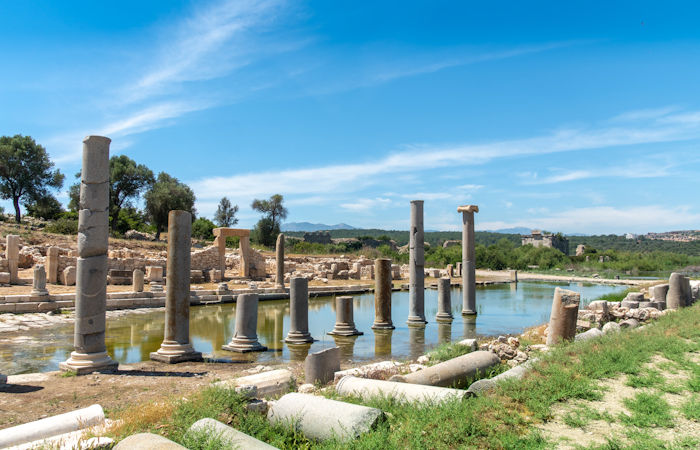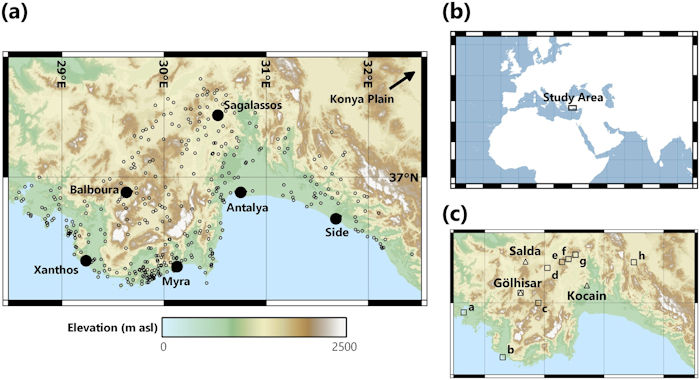Jan Bartek – AncientPages.com – A new study of the ancient world of Anatolia—now Turkey—shows how they adapted to climate change but offers a warning for today’s climate emergency.
The efforts of ancient populations to minimize the impacts of climate change were undermined during longer climate shifts when it is combined with other events such as pandemics, earthquakes and wars—findings the lead author says offer scary parallels to the modern day.

Ancient ruins of Patara city. Credit: Adobe Stock – Scottiebumich
Dr. Matthew Jacobson, an archaeology lecturer, in the Glasgow’s School of Humanities | Sgoil nan Daonnachdan, and corresponding author on the study, said: “Our results suggest it is too simple to say ‘when the climate goes bad, bad things happen to people and society declines.’ We see settlement numbers and agricultural productivity sky-rocket during the Roman period, when conditions were much drier in SW Anatolia.
“We also see people initially adapt to a significant shift to dry conditions in the 5th century but start to struggle around a century later as the climate doesn’t improve and the region is hit by the plague, as well as numerous earthquakes and wars.”
Dr. Jacobson added: “This brings both good and bad news for the modern era as it suggests we can overcome anthropogenic climate change, but only if we act to reduce its influence and keep on top of other disasters. There are scary parallels to recent events considering our increasingly unstable climate, ongoing pandemics, and current conflicts. However, I remain hopeful that we can learn from these historical examples to build resilient societies and become sustainable.”
The team, including, the University of Glasgow (Scotland,U.K.); University of Georgia (U.S.); University of Southampton (England, U.K.); the University of Basel (Switzerland) and Trent University (Ontario, Canada) have published their findings in a new PLOS ONE paper.
The study compiled historical and archaeological evidence for 381 settlements in Lycia-Pamphylia in southwest Anatolia (present day Turkey). Researchers looked at six historical periods from the Bronze Age (3000–1150 BCE) to the Middle Byzantine period (600–1050 CE).
This region is rich in archaeological remains including cities, harbors and rural settlements, as well as high-quality paleo-climate and paleo-environmental archives. To have high quality evidence for ancient people, climate, and the environment (including agriculture) so close to one-another is exceptionally rare.
Paleo-climatic study looks at climate changes that have happened in the past in order to better understand our present and future. This study primarily uses climate data based on chemical analysis of a cave stalagmite (that was also produced by Dr. Jacobson), which is supported by evidence from two nearby lakes.
The PLOS ONE paper says: “Interpreting changes in the number and locations of settlements for each period presents significant challenges, ᴀssociated with chronology, interpretive uncertainty, and preservation bias. However, some patterns are still observable and broadly consistent with the regional history, archaeological evidence, and paleoenvironmental data. The clearest of these trends is a steady increase and peak of settlement numbers in the Roman and Early Byzantine periods, followed by a significant reduction of Middle Byzantine evidence. These changes are consistent with data from across the Eastern Mediterranean and are frequently hypothesized to result in part from changing climatic and environmental conditions.”

Maps of the study region. These were created in QGIS using the ASTER Global Digital Elevation Model v3 as a basemap [13]: (a) All TIB 8 settlements, with elevation data displayed using a topographic color ramp. Important locations are named, ancient (modern) names: Xanthos (Letoön), Balboura (Çölkayiğı), Myra (Demre), Attaleia (Antalya), Side (Manavgat). (b) Location of study region within the Eastern Mediterranean. (c) Lycia-Pamphylia with paleoclimate records (triangles, named) and pollen records (squares), referenced in-text. Pollen records are: Köyceğiz (a), Ova (b), Söğüt (c), Pınarbaşı (d), Bereket Basin (e), Gravgaz Marsh (f), Ağlasun (g) and Beyşehir (h). Credit: PLOS ONE (2022). DOI: 10.1371/journal.pone.0270295
The paper adds: “Overall, we demonstrate that simple correlations between favorable (wetter) or adverse (drier) climatic conditions with positive or negative socio-economic conditions have numerous caveats… Lycia-Pamphylia flourished during the drier Roman period, evolved during another period of aridity after 460 CE, but suffered under the weight of multiple pressures (political, environmental-climatic, seismic, pathogenic (like the bubonic plague) after the mid-6th century.”
In a recently published similar article, co-authored by Dr. Jacobson and covering the same time period, a long drought in Yemen was found to have weakened the Kingdom of Himyar to a state where they could not defend themselves during an invasion.
The study was published in PLOS ONE
Written by Jan Bartek – AncientPages.com Staff Writer





